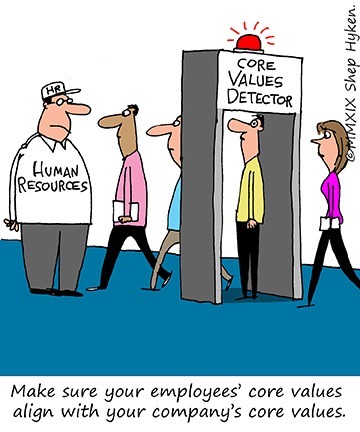Shep Hyken's Blog, page 132
February 11, 2019
5 Top Customer Service Articles for the Week of February 11, 2019
Each week I read a number of customer service and customer experience articles from various resources. Here are my top five picks from last week. I have added my comment about each article and would like to hear what you think too.
Anatomy of the VP Customer Experience Role by Lynn Hunsaker
(CustomerThink) If “customer experience” has innumerable interpretations, the same can likely be said about the ideal role of the Head of Customer Experience.
My Comment: This is a great article for leadership to understand the role and need of the Chief Customer Officer (or whatever title a company uses for the same responsibilities.) And, be sure to pay attention to the comments at the end of the article. The author posted additional content when she posted and responded to comments and feedback.
The 3 AI use cases you can implement across departments by Suzie Blaszkiewicz
(GetApp) Artificial intelligence isn’t just blurring the lines between human and machine. It’s softening the edges that keep sales, marketing, and customer service operating in separate boxes.
My Comment: AI seems to be the center of attention these days. I believe there must be a balance between digital-to-human and human-to-human customer support. This article focuses on three good uses for AI; automation, personalization and conversation. When it comes to conversation, I like using AI for pushing information to the customer (such as when your order ships, where it is, etc.).
15 Net Promoter Score Statistics You Need To Know In 2019 by Anna Pogrebniak
(Lumoa) With the growing understanding of customer experience importance, more and more companies are closely watching their customer feedback.
My Comment: One of my favorite feedback measurements is NPS (Net Promoter Score). Here are some interesting stats and facts that will give you further insight into the power of the simple question, “On a scale of 0-10, what is the likelihood that you would recommend us to a friend or colleague.”
Great Customer Experiences Start With Your Employees by Paul Phillips
(Forbes) By starting from an employee-centric approach to business, you’ll be that much closer to delivering something compelling to your customers.
My Comment: This short article has a powerful message that I’ve preached for a long time. A great reminder that the best customer-focused companies recognize that it starts inside with a focus on employees.
How Invisible Ropes Ruin the Customer Service Experience by Jeff Toister
(Toister Solutions) This post will help you identify invisible ropes that might annoy your customers and ruin their experience.
My Comment: What is an invisible rope? It’s something that the customer may not actually see, but causes a negative reaction. That’s the short version of a powerful lesson that Jeff Toister teaches in this excellent article about what I refer to as subconscious loyalty killers.
BONUS
5 Ways Businesses Can Improve Telephone Customer Service by Riley Panko
(Clutch) People value an efficient resolution to their issue and most dislike being kept on hold when calling a business. Reducing hold times, using digital channels, and seeking outside resources like virtual assistants help optimize a business’ telephone customer service.
My Comment: I’ve shared quite a few articles on customer service on the phone in the past few months, but couldn’t resist sharing this excellent article on how to improve telephone customer service. So, here’s a bonus article to enjoy.
Shep Hyken is a customer service expert, professional speaker and New York Times bestselling business author. For information on The Customer Focus customer service training programs go to www.TheCustomerFocus.com. Follow on Twitter: @Hyken
customer service training programs go to www.TheCustomerFocus.com. Follow on Twitter: @Hyken
The post 5 Top Customer Service Articles for the Week of February 11, 2019 appeared first on Shep Hyken.
February 8, 2019
Guest Blog: Improving Customer Experience Using Employee Feedback Data
This week we feature an article by Christa Heibel who writes about how important employee feedback is to a successful customer service experience and high CSAT ratings. – Shep Hyken
In my past experience as both a consultant and owner/operator of a BPO, I understand that CSAT surveys tend to get all the attention. Of course, this is with good reason. CSAT surveys are critical in determining challenges that your customers are facing so that you may improve the customer experience. However, I want to discuss one of the crucial elements that companies and their contact centers tend to ignore when aiming to provide good customer service experience and obtain high CSAT rating. That element is employee feedback.
Employee Feedback – Pure Gold!
Think about it – your customer-facing employees, such as your agents, are your customer experience frontline. Your frontline employees have an intimate understanding of internal matters such as your company’s policies, processes and procedure. They also understand your customers, perhaps better than your executive team. They directly hear what the customers’ problems are and have a finger to the pulse of what your customers need. Their knowledge of your internal processes and customer needs are, quite literally, a gold mine!
They Know Your Customers
One of the keys to success in operating an effective customer service front, whether you are in a brick and mortar storefront or a contact center, is knowing how your customers define good customer service. Your customers will sing praises if you provide a great product or service, but can also be vocal when they feel like their needs are being met. Yes, your reporting can tell you that you have long wait times, high abandonment rates, or low CSAT scores. However, it cannot always tell you why. There may be a rigid policy that your customers feel are unfair. Perhaps your website is down or there is a glitch in your system that is causing a rise in customer interactions.
Your frontline employees are typically on the receiving end of complaints, comments, and customer feedback. This is why it is critical to regularly tap into your frontline employees and ask them about the concerns that your customers are having. Sure, you can’t please everyone, but you may find that some of these issues are becoming an unwanted trend. It is better that you hear from your employees and you nip the problem in the bud, rather than finding out about it later after your customers have blasted you on social media.
Another thought to consider is that many customers will simply ignore a CSAT survey. If they feel disgruntled enough, they may decide to provide a survey. However, many customers will simply stop doing business with you. In a situation like that, you may have zero insight as to why your customer decided to leave. This is why it is important to tap into your gold mine—your frontline employees.
It’s an Inside Job
When you ask your employees for feedback, it makes them feel empowered and valuable. Letting them say what they feel about their work increases their satisfaction How so? It gives them a chance to be heard. It gives them a voice. It builds their trust in you as an employer, as someone who values their opinion. This will lead to a better company image and potentially increase productivity and performance.
Obtaining their comments about the workplace and customers gives you a better perspective of your company. You can ask them about culture, their relationship with management and their peers, and the things they need to perform well in their given roles. This can lead to game-changing results and can shed light on new, innovative perspectives and approaches that you had not considered before. An employee can also shed light on other issues that can affect the customer experience such as employee attrition, poor management, or broken processes.
What You Can Do
First, obtain employee feedback through a company-wide survey. The alternative is to let their team leaders interview them one by one. However, it is not enough to just do one survey and be done with it. When developing a survey strategy, aim to launch a regularly scheduled employee survey.
The second step is to verify the information. You can do that by listening to recordings, reviewing e-mail threads or any other documentation of the customer interaction. It is a must that you review both good and bad interactions to make the verification process easier.
Third, create an action plan and perform a split test. Group A will perform the changes you wrote in your plan and group B will perform what they have been doing before. The strategy or plan that garners more CSATs will be the one that your organization will use moving forward.
Employee feedback can be the driving force of new ideas that can transform your customer experience from the inside out. however, collecting data is not enough. You must collect, verify, analyze, plan and act. Through careful planning and execution, you can utilize feedback as a vehicle of change for organizational growth and an improved experience for your customers.
Christa Heibel is the Founder/Owner of CH Consulting Group where she leads a nationwide network of Customer Experience Consultants that specialize in the Omni-Channel Contact Center . Christa brings 25+ years of contact center experience to the table where she has successfully developed, implemented and managed numerous contact center operations across the U.S.
For more articles from Shep Hyken and his guest contributors go to customerserviceblog.com.
Read Shep’s latest Forbes article: Eight Ways To Thank Your Customers For Valentine’s Day
The post Guest Blog: Improving Customer Experience Using Employee Feedback Data appeared first on Shep Hyken.
February 6, 2019
Core Values are Decision Filters
 I’m honored to be the keynote speaker later this year at Office Pride, a franchisor of commercial cleaning service companies. All of the franchisees will be attending their annual meeting to network and learn about the latest and greatest opportunities happening in their industry. My job is to talk to them about customer service.
I’m honored to be the keynote speaker later this year at Office Pride, a franchisor of commercial cleaning service companies. All of the franchisees will be attending their annual meeting to network and learn about the latest and greatest opportunities happening in their industry. My job is to talk to them about customer service.
As part of my homework, Todd Hopkins, their CEO, shared the Office Pride Culture book. As I was reading it, I came across a concept worth sharing. While Office Pride has created a great set of core values, Todd describes them as decision filters. He writes, “Our core values filter the outcome of what we, either impulsively or mindfully, decide to do.”
Core values are what an organization believes and stands for. These are the principles and beliefs that guide an organization – and the employees of that organization. Many organizations’ core values include words like honesty and integrity. Office Pride’s core beliefs and values are as follows:
Honor God
Always Do What is Right
Increase Brand Value
Demonstrate Honesty, Integrity, and Hard Work Ethic
Total Customer Satisfaction
Go the Extra Mile
Persevere with a Servant’s Attitude
Accountability to Commitments
The key for core values to work is to keep them in front of you, memorize them, and be conscious of how they tie into your daily behavior with your customers and employees. Just writing them down without acting on them is simply a writing assignment.
Tony Hsieh, the CEO of Zappos, came up with ten core values for his company. In his book, Delivering Happiness: A Path to Profits, Passion, and Purpose, Hsieh says he hires for those core values. He will also fire for a lack of any of the core values. That’s how important they are to the health of his organization.
It was Tony Hsieh’s book that inspired Hopkins to write his own culture book, which is a great exercise for an organization to consider. This short 84-page book devotes a chapter to each of his eight core values, supported by examples of how Office Pride employees and franchisees live by them.
So, back to Mr. Hopkin’s concept of core values being a filter. If you are working for a company or going to work for a company, take time to understand their core values. Do they align with what you believe in? Can you live by these values? Is this the culture that you want to be a part of? If the answer is yes, then let the values be the natural filter that guides the way you perform and treat others.
Shep Hyken is a customer service expert, keynote speaker, and New York Times bestselling business author. For information, contact 314-692-2200 or www.hyken.com. For information on The Customer Focus customer service training programs, go to www.thecustomerfocus.com. Follow on Twitter: @Hyken
customer service training programs, go to www.thecustomerfocus.com. Follow on Twitter: @Hyken
The post Core Values are Decision Filters appeared first on Shep Hyken.
February 5, 2019
Amazing Business Radio: Brian Sprinkle

Big Ass Fans
Growing Customer Service Alongside Your Company
Shep Hyken interviews Brian Sprinkle. They discuss his company, Big Ass Fans, and their approach to providing high-quality customer service to support their industry-leading products.








In Shep’s Opening Monologue…
He compares the profitability of customer acquisition versus customer retention.
The Interview with Brian Sprinkle:
It costs 5 to 7 times more (on average) to acquire a new customer than to retain an existing customer. You can grow your business, in part, by creating repeat customers.
If you focus on making the customer want to come back next time every time, that will turn into a lifetime of business.
The company makes great use of surveys to assess its customer service. Short surveys are sent out after the initial sale, 90 days after the sale, and after a support ticket is closed.
There is a Customer Advocate position at Big Ass Fans whose sole job is to be the voice of the customer within the company. They go through and read every survey and communicate with other departments and employees to make changes and reinforce behavior.
Companies need to train and support their customer service agents for those agents to provide exceptional service to their customers.
Quotes:
“If you can keep your employees happy, they’re extremely likely to make customers happy.” – Brian Sprinkle
“If you want to have excellent customer service agents who provide excellent support to customers, the first step is providing those agents with excellent support.” – Brian Sprinkle
About:
Brian Sprinkle is the Global Customer Service Manager at Big Ass Fans, the world’s leading manufacturer of high-volume, low-speed fans.
Shep Hyken is a customer service and experience expert, New York Times bestselling author, award-winning keynote speaker, and your host of Amazing Business Radio.
This episode of Amazing Business Radio with Shep Hyken answers the following questions … and more:
Is customer retention more profitable than customer acquisition?
What are the key qualities to look for in customer service employees?
How do companies use surveys to improve their customer service?
How can companies increase survey response rate?
What is the number one step to take to ensure customer happiness?
The post Amazing Business Radio: Brian Sprinkle appeared first on Shep Hyken.
February 4, 2019
5 Top Customer Service Articles for the Week of February 4, 2019
Each week I read a number of customer service and customer experience articles from various resources. Here are my top five picks from last week. I have added my comment about each article and would like to hear what you think too.
Why Customer Experience Matters for B2B by Suketu Gandhi, Alanna Klassen Jamjoum, and Conrad Heider
(Sloan Review) Better omnichannel experiences mean more sales on consumer sites, but this logic is often neglected when it comes to B2B.
My Comment: So many customer experience strategies (CX) seem to focused on B2C. I’ve been a strong advocate for B2B companies to understand their customers’ expectations are being influenced by consumer behavior (mostly from retailers who deliver an outstanding experience). This article promotes that CX is also an important strategy for B2B. Great ideas for any type of business – especially B2B.
5 Over-Hyped CX Trends You Should Reconsider by Kindra Cooper
(CCWDigital) Industry predictions don’t always align with reality.
My Comment: I like an article that takes issue with the status quo. This article takes five trends, some of which I 100% agree with, and takes the opposite viewpoint. While I didn’t agree with some of what’s in here, it made me think. There’s merit to all of the author’s points. So read, think and reconsider some of your beliefs about the CX trends are impacting your business.
New Capgemini Research Reveals Consumers Want Even Faster Online Grocery Deliveries by Lana Bandoim
(Forbes) A recent study from Capgemini reveals that half of all consumers are willing to switch to a competitor who offers faster online delivery services for groceries.
My Comment: Just because this article is focused on groceries, don’t think it doesn’t apply to your business. The message is clear. Customers want to do business with the companies that save them time. Saving time is another version of being more convenient. So, take a lesson from the grocery industry. Respond faster, deliver quicker and be more convenient than your competition.
Using AI To Get Closer To Your Customer by Abhi Yadav
(Forbes) Artificial intelligence (AI) is a game-changer for customer experience. It has the ability to bring unprecedented results in delivering relevancy and individualism while increasing marketing accuracy. It may even help you understand your customer’s needs before they realize it themselves.
My Comment: This article starts with a quote from Steve Jobs: “Get closer than ever to your customers. So close that you tell them what they need well before they realize it themselves.” With that thought planted in your mind, it goes on to cover several ideas on how to use AI to get closer to your customer and deliver a CX that they want and need (“even before they realize it themselves”).
The 75 Customer Service Statistics You Need to Know in 2019 and Beyond by Reuben Yonatan
(Get VoIP) Understanding what your customer needs and expects from their experience with you is the key to achieving your targets and ultimately, growing your business.
My Comment: This is an article and infographic combined; 75 stats and facts to make you think about your customer service and experience. There is everything from why service matters to info on AI, chatbots, data and more. Some of the stats are more recent than others, but regardless, they will make you think. A great resource!
BONUS
What does customer service mean to you in 2019? by Anastasiia Khlystova
(HelpCrunch) We decided to ask real CEO’s and customer service representatives about what worked for their companies and what they’re going to change this year. What we got are 24 excellent battle tested quotes on what customer service means for them in 2019.
My Comment: You are going to love this one. 24 tips, each one with an entertaining GIF. Honored to be quoted in the article, too. Have fun with this one… and learn!
Shep Hyken is a customer service expert, professional speaker and New York Times bestselling business author. For information on The Customer Focus customer service training programs go to www.TheCustomerFocus.com. Follow on Twitter: @Hyken
customer service training programs go to www.TheCustomerFocus.com. Follow on Twitter: @Hyken
The post 5 Top Customer Service Articles for the Week of February 4, 2019 appeared first on Shep Hyken.
February 1, 2019
Guest Blog: Building a Customer-Centric Culture Around CRM Software
This week we feature an article by Dawn Gucciardo who took my model of Six D’s to Creating a Customer-Centric Culture and applied it to developing and implementing a CRM software. – Shep Hyken
Shep Hyken believes customer centricity must start on the inside, with your employees. Guess what? The same goes for developing and implementing a CRM software!
As a business owner, operations manager or stakeholder, it is common to invest time, effort and money into building a customer-centric human workforce to help execute a business strategy. Don’t throw all that away by implementing a piece of software that makes the employee’s job more difficult, takes longer (without any benefits) or adds no value to individual tasks. Customer service is everyone’s job— from sales reps, finance, IT, operations, to management— and the more employees buy into it, the more they will exceed in providing higher quality service.
It only makes sense to start with your employees as they will be using the software front and center. Keeping the employee’s needs in mind helps build the application in such a way that it supplements their role and assists in performing more in less time. It is imperative for employees to focus more of their time on the revenue-driving tasks instead of the mundane tasks that typically aren’t revenue-drivers.
As a reference, Shep defines the Six D’s of Creating a Customer-Centric Culture in his Customer Service Blog:
Define it. – Imagine the desired customer experience.
Disseminate it. – Communicate and train employees on what that experience looks like.
Deploy it. – Roll out the customer service initiative to everyone.
Demonstrate it. – Everyone leads by example.
Defend it. – If it is apparent that the current customer experience isn’t ideal, intervene and provide coaching.
Delight in it! – Celebrate the success of amazing customer service!
The same may be described for developing and implementing a CRM software.
6 Steps for Creating Customer Centricity around CRM
Define It.
Taking a “day in the life” approach is a great way to define what is needed for employees to easily perform their role during the process, regarding data points and reporting. During this stage, reviewing the necessary adjustments and describing how the software will affect your company’s culture is highly recommended. This is an essential step to warming up your company to the sweeping changes ahead.
Impact: As a result, employees that contribute to the design are highly engaged and more likely to embrace change as they feel like a part of the process.
Disseminate It.
Training employees on how to use the application using specific “A day in the life” scenarios is vital. For example, demonstrating specific instances of how employees can use the software will benefit them more than covering every single feature at once. In addition, make the training a hands-on experience; a classroom-like environment with workshops is better than one jumbled lecture-like session. By providing real-life scenarios in training sessions, you are preparing users for deployment. Also, communicating the benefits and the business impact to the company overall may lead to higher engagement.
Impact: By providing real-life scenarios during training, it will better prepare your users for deployment.
Deploy It.
Ensuring that all end-users are up and running is crucial. Provide a “safety net” with a real-time Service Level Agreement for the first week. This type of immediate response takes pressure off users as expectations will adapt to their needs. So, if something in the software goes wrong, isn’t clarified, or doesn’t work as anticipated, most changes can be made in the agreement to address specific pain points.
Impact: Employees will be more confident knowing that if they forgot something or if they made a mistake, they are covered.
Demonstrate It.
Demonstration requires that stakeholders understand how the CRM is being used and to communicate with each other when key company milestones are achieved, or when an employee has reached an individual milestone. Demonstration is all about alignment. Given that CRM software usually involves major changes, it is key that everyone involved with the software is on board and is using it properly.
Impact: The “boss” recognizes how much work employees are putting into their customer interactions, which increases motivation. Key stakeholders are “in-touch” and are able to have intelligent, relevant discussions concerning customer issues.
Defend It.
Maintaining data integrity to help ensure the application is working as intended is necessary. Also, most organizations rely on data to make decisions, so with inaccurate data, customers are going to feel the effects. Therefore, continuously monitor user adoption and address issues immediately. Staying abreast of business changes and enhancing the application as needed is very important.
Impact: Face it, issues are going to arise because humans will be humans, and humans created the application. It is not the issue so much as how the issue is handled. Refer to the steps above so it is handled properly.
Delight in It!
Bringing in donuts to celebrate when a specific team meets their goals or buying lunch for the employee that sold the most widgets for the week is worthwhile. Point being, revel in the success and make the hard work rewarding!
Impact: Happy employees. Happy Customers.
Happy Customers Through Happy Employees
The easiest way to build a CRM software around customers is to have your employees involved every step of the way. Employees and stakeholders that are out of touch with the software will be out of touch with customers. When motivated, employees are challenged to think of relevant customer interactions during a CRM project, and success is guaranteed.
 As a Senior CRM Consultant for Indusa, Dawn Gucciardo is a functional leader, helping clients plan, implement, and adopt leading customer enablement technologies. Dawn’s passion and focus include understanding client needs, analyzing their business processes, and managing implementation efforts.
As a Senior CRM Consultant for Indusa, Dawn Gucciardo is a functional leader, helping clients plan, implement, and adopt leading customer enablement technologies. Dawn’s passion and focus include understanding client needs, analyzing their business processes, and managing implementation efforts.
For more articles from Shep Hyken and his guest contributors go to customerserviceblog.com.
Read Shep’s latest Forbes article: I Just Want To Talk To A Human!
The post Guest Blog: Building a Customer-Centric Culture Around CRM Software appeared first on Shep Hyken.
January 30, 2019
The Best Feedback Question
“Please stay on the line to answer a short, one-question survey at the end of this call.”
That’s what I heard just before the agent picked up the phone to help me. Just a one-question survey? Sounds short enough. Sure, I’ll give them an extra minute of my time. So after the call, I stayed on the line. What came right after the call was the promised simple question. It may be one of the best feedback questions I’ve ever heard. I put it right up there with the NPS (Net Promotor Score) question, which I’ll share later. Here it is:
“The next time you call us, would you want the same person to take care of you? Push 1 for yes and 2 for no.”
That’s it. It’s that simple. In one quick question, the customer gets to grade the support rep that took the call. It sums up if the customer was happy and if the agent did their job. No, it doesn’t tell you if the problem was resolved or not, but that question could be for another day. I started to think about other one-question surveys that can give you a snapshot of what a customer thinks about a company. Here are a few questions to get you thinking—and each of these questions can be answered using the keypad of a phone.
Let’s start with the one that prompted me to write this article: the next time you call us, would you want the same person to take care of you? Push 1 for yes and 2 for no.
The Net Promoter Score: On a scale of one to ten, what’s the likelihood you would recommend us to a friend or colleague?
Was the question answered or the problem resolved to your satisfaction?
On a scale of one to ten, how would you rate our customer service?
On a scale of one to ten, how would you rate the quality of our product?
The secret to the success of the survey is the simplicity and speed by which the questions can be answered.
In the perfect survey world, I like to follow up one of these questions with an open-ended question. Obviously, you can’t answer that on a telephone dial pad, but if you email or text, you can follow up a simple question with a, “Why did you give us that score?” kind of question.
I’m often asked by clients how to get more responses from customers who are sent surveys. You now know the secret: simplicity and speed. Just promise that it won’t take a lot of time – a minute or less – and watch how many more surveys your customers take.
Shep Hyken is a customer service expert, keynote speaker, and New York Times bestselling business author. For information, contact 314-692-2200 or www.hyken.com. For information on The Customer Focus customer service training programs, go to www.thecustomerfocus.com. Follow on Twitter: @Hyken
customer service training programs, go to www.thecustomerfocus.com. Follow on Twitter: @Hyken

The post The Best Feedback Question appeared first on Shep Hyken.
January 29, 2019
Amazing Business Radio: Ryan Minton

Thanks for Coming in Today
Taking Care of Employees So They Can Take Care of Customers
Shep Hyken interviews Ryan Minton. They discuss his new book, “Thanks for Coming in Today,” the hospitality industry, employee and customer appreciation, and the concept of aggressive hospitality.








In Shep’s Opening Monologue…
He discusses current trends in the digital customer service world.
The Interview with Ryan Minton:
Having employees with a mentality of hospitality is always preferable to having employees with technical know-how.
A successful business comes not only from having happy customers, but from having happy employees.
Make a habit of showing appreciation to everyone in your business—employees, colleagues, and customers. Appreciation goes a long way.
Operate with “aggressive hospitality.” Good customer service isn’t passive; it’s active, and you need to pursue it.
Look forward to opportunities where you get to be someone’s first boss and use those opportunities to mentor your employees in the ways of good customer service. You get to establish what it means to be a great manager or leader.
Eliminate the phrase, “let me check with my manager” by giving your employees the tools and trust to handle issues.
Empathy is crucial in delivering a positive customer experience. Put yourself in the customer’s shoes and allow that to drive your customer service.
Quotes:
“Your employees have to understand that their job matters and that they matter.” – Ryan Minton
“Take care of the employees, and they’ll take care of the customer.” – Ryan Minton
“You have to be aggressive. You can’t just coast through customer service.” – Ryan Minton
About:
Charles Ryan Minton is a customer service and employee experience expert, keynote speaker, author of, Thanks for Coming in Today: Creating a Culture Where Employees Thrive & Customer Service is Alive, and the president of CRM Hospitality & Consulting, LLC.
Shep Hyken is a customer service and experience expert, New York Times bestselling author, award-winning keynote speaker, and your host of Amazing Business Radio.
This episode of Amazing Business Radio with Shep Hyken answers the following questions … and more:
What are the current digital trends in customer service?
Why is the appreciation of both employees and customers so important?
What is aggressive hospitality?
How can I show appreciation to my employees and customers?
How can I be the best first boss?
The post Amazing Business Radio: Ryan Minton appeared first on Shep Hyken.
January 28, 2019
5 Top Customer Service Articles for the Week of January 28, 2019
Each week I read a number of customer service and customer experience articles from various resources. Here are my top five picks from last week. I have added my comment about each article and would like to hear what you think too.
What Do Customers Really Think Of Your Brand? by Athina Mallis
(Which-50) Every marketer has heard a horror story where a brand went viral for horrible customer experience with social media enhancing the frequency of those stories twofold.
My Comment: Too often an organization’s leadership believes the experience and service they provide a customer is better than it actually is. This article has some interesting comments about which industries deliver the worst overall service. And, something I noticed… the technology space, which includes internet, cable and cellular, is no longer one of the top one or two worst service providers. (They are trying!)
The 14 Rules of History-Making Teams by Josh Linkner
(Josh Linkner) Having studied high-performing cultures for over two decades, as well as building five companies of my own, I’ve discovered the 14 core beliefs of the highest performing teams.
My Comment: With the Super Bowl just around the corner, the title of the article by innovation expert Josh Linkner caught my eye. The 14 “rules” are actually some pretty darn good tips for delivering a better customer experience. Consider rule number one, which is “Play like you want to be remembered,” Not a bad strategy for any company that wants to win over their customers.
Adapting Service to Various Generations by Teresa Allen
(Allen Speaks) I was just talking with a representative of a local insurance agent who mentioned that the older clients love her. Why? Because they love the fact that she listens to them and takes time with them and will explain slowly any technology that they may not understand.
My Comment: One of the great concepts in customer service is the practice of adaptability. Traditionally, this has been about behavioral styles. You recognize certain behaviors from your customer, and you adapt and play to those behaviors. Today, you not only have to adapt to behaviors but also to generational differences. We all know that baby boomers are different than millennials but do we act accordingly? Teresa Allen has written a very nice article about adapting to generational styles. While an excellent concept for customers, it is also appropriate for the colleagues you work with.
Social media customer care best when humans and bots are at play by Tara Jones
(Retail Customer Experience) Here are five considerations for a mindfully sound social care strategy.
My Comment: It’s been a while since an article about the balance between human and digital (bot) customer support has been on this list. I liked the examples of how social media customer care is still playing a role in customer service and support, and how to properly use a bot or computerized response versus a human response. Used together, it is a powerful solution to getting customers the information they need quickly and their problems/complaints resolved efficiently.
My Comment: We end this week’s Top Five with not an article, but a short one minute video. It answers the question, “If customer service were a fruit, what fruit would it be, and why?” Get ready to smile!
BONUS
The State of Bots in 2019: Successes and Failures by Astrid Monge
(Fonolo) According to Forrester, today’s “consumers have more tech at their disposal than ever before and it has fundamentally changed how they experience brands.”
My Comment: I like this article, not because it mentions my name in the first sentence, but for two other reasons. First, it continues the discussion from the fourth article on this week’s list about bots and human interactions. Second, because it links to Fonolo’s free report, “The Top Contact Center Trends to Watch in 2019.” Download it today!
Shep Hyken is a customer service expert, professional speaker and New York Times bestselling business author. For information on The Customer Focus customer service training programs go to www.TheCustomerFocus.com. Follow on Twitter: @Hyken
customer service training programs go to www.TheCustomerFocus.com. Follow on Twitter: @Hyken

The post 5 Top Customer Service Articles for the Week of January 28, 2019 appeared first on Shep Hyken.
January 25, 2019
Guest Blog: Rhyme Your Way to Customer Satisfaction
This week we feature an article by Dr. Marlene Caroselli shares a rhyme that will help you to communicate with customers and provide customer satisfaction. – Shep Hyken
It’s important to have a verbal safety net that will rescue you, especially when an angry customer is calling your office, This easy-to-remember rhyme will help you help your customer find satisfaction. The four words—Fear, Hear, Mirror, and Steer—could even be printed and be kept near your phone so you can rely on them quickly and smoothly. The steps associated with each word are detailed as follows.
1. Fear
Above all else, a dangerous caller must be dealt with immediately. Be certain your office has established measures to be taken if the caller is threatening. Those might include transferring the call to a manager or to security. In a worst-case scenario, to the police.
Most callers, of course, will simply be seeking information. And some may be calling to express their dissatisfaction. The “fear” that may permeate a customer-exchange will seldom be experienced by you, the company’s representative. Most often, it will be the caller experiencing some measure of fear—usually fear that he will not have concerns addressed. If your company has been in business for more than a month, you know there is a pattern to the incoming calls. Knowing what customers’ concerns are will make it easier to develop a script, one that will assure callers that their specific issues are being addressed.
2.Hear
Ideally, customer service representatives in your company are undergoing periodic training to ensure they are truly listening to customers; concerns. If this training has not yet occurred, you can take a leadership role by having informal training sessions. Or, by emailing short pointers on, for example, the importance of not interrupting a caller. Or, by asking questions at the appropriate time. Or, by learning about best practices in other companies and incorporating some of those into your own. Your Human Resources department should be able to assist you in this endeavor.
3. Mirror
There are both verbal and non-verbal ways to assure the customer that she is being heard. If you are speaking with a customer or potential customer, you can nod to assure her that her concerns have been understood, her questions will be addressed. You can shake hands at the end of the exchange, too. If the individual is calling or emailing, you can mirror her comments by summarizing near the end of the communication, thus showing your eagerness to have captured everything that was important to her.
4. Steer
If you cannot handle the customer’s problem yourself, be sure you know to whom you can “steer” him in order to have that problem satisfactorily resolved. Again, most of the calls coming in will have a similar and familiar ring to them. The reasons for the customers’ calls are ones you’ve probably heard before. Thus, you should have a list of the persons or places to which you can refer the customer. Don’t fumble for extension numbers—have those ready.
There’s a possible “E” here—another rhyming word that will complete the customer-satisfaction circle: Reappear. Depending on the nature of the resolution, you may wish to contact the customer again in the future—in a few hours, a few days, a few months. When you “reappear,” express appreciation for the customer having brought the problem to your attention. Say that you hope the earlier discussion resolved that problem. Offer to speak with the customer again if he has any further comments to share.
If you agree with Shiv Singh that the “purpose of a business is to create a customer who creates customers,” then you’ll Fear-Hear-Mirror-Steer your way to an ever-expanding customer base.
Dr. Marlene Caroselli is an author, keynoter, and corporate trainer who writes extensively about education, business, self-improvement, and careers and has adjuncted at UCLA and National University. Her first book, The Language of Leadership, was named a main selection by the Executive Book Club. Principled Persuasion, a more recent title, was designated a Director’s Choice by the Doubleday Book Club. Applying Mr. Albert: 365+ Einstein-Inspired Brain Boosts, her 62nd book, was released by HRD Press in 2018.
For more articles from Shep Hyken and his guest contributors go to customerserviceblog.com.
Read Shep’s latest Forbes article: Delta, We’re Ready When You Are!
The post Guest Blog: Rhyme Your Way to Customer Satisfaction appeared first on Shep Hyken.



